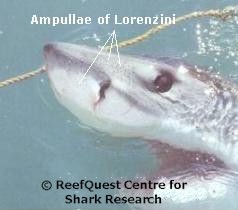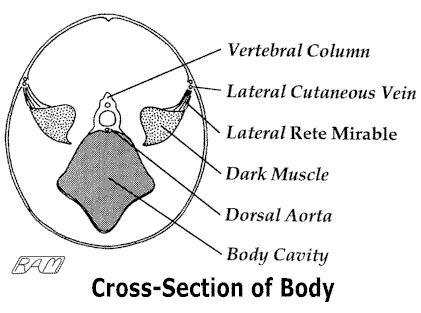Adaptations of the Great White Shark

Size
Among the very largest of sharks, the Great White regularly reaches a length of 20 feet and a weight of more than two tons. There is reasonably good evidence that this species can reach lengths of 23 or even 26 feet, but such individuals are notoriously difficult to confirm - let alone weigh.
Color
As with other animals, the Great White's color is highly variable. In general, the species is dark above and white below, a patterns called "countershading". Countershading makes the Great White difficult to see because it reduces the contrast between its belly in the shadow of the shark's bulk and its back illuminated by sunlight. Back and flank color in the Great White ranges from bronzy and greyish brown to various shades of grey. Pacific Coast specimens tend to be very dark - almost black - above. This darkness helps camouflage the Great White against the dark, rocky bottom over which it typically swims.
Skin
Like other sharks, the skin of a Great White is very tough and studded with tiny, tooth-like scales called "dermal denticles". Dermal denticles protect the skin from damage and are replaced continually. Each individual denticle has a flat, table-like crown that has a series of raised ridges. These ridges reduce the drag and noise generated by a shark's swimming movements, enabling the Great White to glide efficiently in ghost-like silence.
Jaws
As in other sharks, the upper jaw of a Great White is not fused to the skull. Instead, the jaws are slung loosely beneath the skull, held in place by flexible connective tissue and braced by accessory cartilages. Special muscles pull the jaw complex forward and down, riding on grooves on the undersurface of the skull. This arrangement allows a Great White to protrude its jaws outward from the head, extending the reach of its teeth and creating a partial vacuum that helps suck in prey.
 |
TeethThe teeth of a Great White have broadly triangular blades with coarsely serrated edges. The upper teeth are broader and flatter than the lower teeth, which reflects their different roles during biting. The lower teeth stab into and hold secure a food item while the saw-like upper teeth gouge out a hunk of flesh. This dental arrangement allows the Great White to feed on prey too large to swallow whole as well as scoop calorie-rich blubber from whale carcasses. |
Eyes
The eyes of a Great White are relatively large and well developed. The retina (light-sensitive tissue lining the back of the eyeball) of this species contains both rods and cones in a similar ratio to that of humans (about 4 to 1). This suggests that the Great White is highly visual and has acute color vision. Although different parts of its retina are adapted for bright and dim light conditions, it is believed that the Great White is primarily a daytime hunter.
Nostrils
Each nostril of a Great White consists of a flap of skin that controls water movement into a cup-like structure. The cup-like structure contains a roughly spherical scent-detecting organ called an "olfactory bulb". Each olfactory bulb is composed of a series of closely-packed plates of tissue that are extremely sensitive to dissolved chemicals. The Great White has the largest olfactory bulbs of any shark species measured to date, enabling it to locate bleeding prey, decomposing whale carcasses, and seal or sea lion colonies by their distinctive odors.
Electroreceptors
 Like other sharks, the Great White has specialized sensory organs that
detect extremely minute electrical fields. These organs, called "ampullae
of Lorenzini", consist of clusters of miniature testtube-shaped
structures with a sensory hair cell at the base and filled with an
electrically conductive jelly. Externally, the open ends of these ampullae
appear as clusters of tiny pores peppered over the head. These pores are
most richly distributed on the undersurface of the snout and recent work has
shown that each cluster has a peak directional sensitivity. The Great White
uses these electroreceptors to locate hidden prey, such as the tiny
electrical signal of its prey's muscles in the otherwise confusing bloody
froth of a predatory attack.
Like other sharks, the Great White has specialized sensory organs that
detect extremely minute electrical fields. These organs, called "ampullae
of Lorenzini", consist of clusters of miniature testtube-shaped
structures with a sensory hair cell at the base and filled with an
electrically conductive jelly. Externally, the open ends of these ampullae
appear as clusters of tiny pores peppered over the head. These pores are
most richly distributed on the undersurface of the snout and recent work has
shown that each cluster has a peak directional sensitivity. The Great White
uses these electroreceptors to locate hidden prey, such as the tiny
electrical signal of its prey's muscles in the otherwise confusing bloody
froth of a predatory attack.
Ears
As in other sharks, the ears of a Great White are located close together on top of its head. Each ear consists of a pair of sac-like structures to which are attached three semicircular tubes. Each tube is oriented at right angles to the others is lined with sensory hair cells and contains a non-viscous fluid. This arrangement provides a Great White with continuous information on its acceleration and the orientation of its body in all three spatial dimensions.
Lateral Line
Like other sharks, the Great White has a row of sensitive vibration-detectors, called the "lateral line", running along each of its flanks. Together, the two lateral lines allow a Great White to 'feel' the direction of erratic water disturbances caused by struggling or injured animals that might make easy prey.
Gills
All sharks breathe by means of gills, but those of the Great White are exceptionally large. Each gill filament consists of a feather-like arrangement of thin-skinned plates. Each of these plates contains tiny arteries called "capillaries" that carry blood in a direction opposite to that of water flow over the gills. This "counter-current" arrangement allows the Great White efficient uptake of dissolved oxygen from the water, enabling it to pursue an active predatory lifestyle.
 Heat
Exchangers
Heat
Exchangers
Although its heart and gills operate at environmental temperatures, portions of the Great White's circulatory system have been modified to allow retention of body heat. On its way back to the heart, blood inside the veins is heated by muscle contraction and other metabolic processes. This heat is transferred to the arterial blood as it passes through a tightly-intermeshed network of tiny veins and arteries. These veins and arteries carry blood in opposite directions, allowing efficient transfer of metabolic heat in what is termed a "counter-current heat exchanger". The Great White has such heat exchangers around its brain, stomach, and swimming muscles, enabling it to function effectively in waters too cold for most other sharks.
Fins
Like other sharks, the Great White has paired and unpaired fins. The pectoral and pelvic fins are paired, while the first dorsal, second dorsal, anal and caudal (tail) fins are unpaired. The pectoral fins control banking, turning, ascending, descending and breaking as well as acting as important signaling structures. The first dorsal fin is important in preventing unwanted roll, keeping the shark on an even trim. The caudal fin is the main propulsive structure, featuring an efficient crescentic shape and supported on either side by sturdy keels. All these fins allow the Great White to finely control its movement through the water.
Reproduction
As in other sharks, the Great White practices internal fertilization. Mother Great Whites retain yolky, thin-shelled eggs within the body until development is complete. Such a reproductive mode is termed "ovoviviparity". After a gestation period of a year or longer, 5 to 10 (and possibly as many as 17) 3- to 5-foot-long pups are born in shallow coastal areas. After birth, the pups receive no parental care and are left to fend for themselves. It is believed that post-partum Great Whites may take a year or more off to rebuild her energy stores before becoming pregnant again.
Life History
By counting growth rings in the vertebrae of Great Whites, scientists have confirmed that these sharks grow slowly and mature relatively late in life. Although age and size at maturity vary somewhat among individuals, male Great Whites mature at an age of 8 to 9 years and a length of 11.5 to 12 feet. Females of this species mature at an age of 14 to 16 years and a length of 14 to 16 feet. The longevity (maximum lifespan) of a Great White appears to be about 30 years.
Distribution
The Great White is one of the most widely distributed of sharks, having been recorded from coastal and insular waters of almost every region of the globe between 60 degrees north and south latitude. It has also been recorded from oceanic islands, including Hawaii, so the Great White is clearly capable of extensive open ocean voyages.
Habitat
The Great White is primarily an inhabitant of cool temperate waters over continental and insular shelves. It seems to prefer areas with rocky bottoms, but it has been recorded over sandy bottoms and on coral reefs as well as in the deep-sea. It was formerly thought that Great Whites do not enter kelp forests, but this has been shown to be false: not only do they enter kelp forests, they apparently also feed there.
